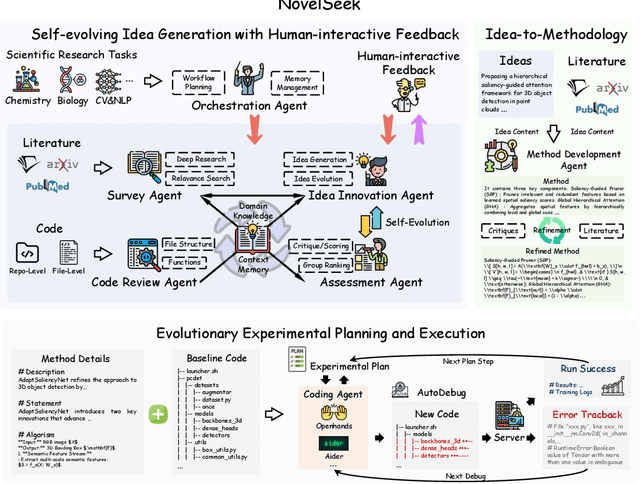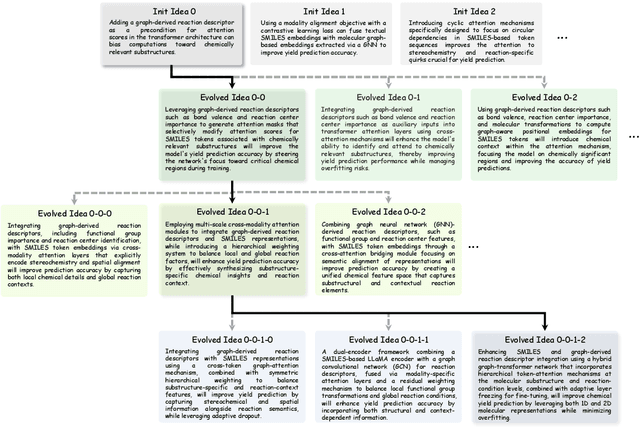Songtao Huang
NovelSeek: When Agent Becomes the Scientist -- Building Closed-Loop System from Hypothesis to Verification
May 22, 2025



Abstract:Artificial Intelligence (AI) is accelerating the transformation of scientific research paradigms, not only enhancing research efficiency but also driving innovation. We introduce NovelSeek, a unified closed-loop multi-agent framework to conduct Autonomous Scientific Research (ASR) across various scientific research fields, enabling researchers to tackle complicated problems in these fields with unprecedented speed and precision. NovelSeek highlights three key advantages: 1) Scalability: NovelSeek has demonstrated its versatility across 12 scientific research tasks, capable of generating innovative ideas to enhance the performance of baseline code. 2) Interactivity: NovelSeek provides an interface for human expert feedback and multi-agent interaction in automated end-to-end processes, allowing for the seamless integration of domain expert knowledge. 3) Efficiency: NovelSeek has achieved promising performance gains in several scientific fields with significantly less time cost compared to human efforts. For instance, in reaction yield prediction, it increased from 27.6% to 35.4% in just 12 hours; in enhancer activity prediction, accuracy rose from 0.52 to 0.79 with only 4 hours of processing; and in 2D semantic segmentation, precision advanced from 78.8% to 81.0% in a mere 30 hours.
TimeKAN: KAN-based Frequency Decomposition Learning Architecture for Long-term Time Series Forecasting
Feb 10, 2025



Abstract:Real-world time series often have multiple frequency components that are intertwined with each other, making accurate time series forecasting challenging. Decomposing the mixed frequency components into multiple single frequency components is a natural choice. However, the information density of patterns varies across different frequencies, and employing a uniform modeling approach for different frequency components can lead to inaccurate characterization. To address this challenges, inspired by the flexibility of the recent Kolmogorov-Arnold Network (KAN), we propose a KAN-based Frequency Decomposition Learning architecture (TimeKAN) to address the complex forecasting challenges caused by multiple frequency mixtures. Specifically, TimeKAN mainly consists of three components: Cascaded Frequency Decomposition (CFD) blocks, Multi-order KAN Representation Learning (M-KAN) blocks and Frequency Mixing blocks. CFD blocks adopt a bottom-up cascading approach to obtain series representations for each frequency band. Benefiting from the high flexibility of KAN, we design a novel M-KAN block to learn and represent specific temporal patterns within each frequency band. Finally, Frequency Mixing blocks is used to recombine the frequency bands into the original format. Extensive experimental results across multiple real-world time series datasets demonstrate that TimeKAN achieves state-of-the-art performance as an extremely lightweight architecture. Code is available at https://github.com/huangst21/TimeKAN.
Applying Ensemble Models based on Graph Neural Network and Reinforcement Learning for Wind Power Forecasting
Jan 28, 2025



Abstract:Accurately predicting the wind power output of a wind farm across various time scales utilizing Wind Power Forecasting (WPF) is a critical issue in wind power trading and utilization. The WPF problem remains unresolved due to numerous influencing variables, such as wind speed, temperature, latitude, and longitude. Furthermore, achieving high prediction accuracy is crucial for maintaining electric grid stability and ensuring supply security. In this paper, we model all wind turbines within a wind farm as graph nodes in a graph built by their geographical locations. Accordingly, we propose an ensemble model based on graph neural networks and reinforcement learning (EMGRL) for WPF. Our approach includes: (1) applying graph neural networks to capture the time-series data from neighboring wind farms relevant to the target wind farm; (2) establishing a general state embedding that integrates the target wind farm's data with the historical performance of base models on the target wind farm; (3) ensembling and leveraging the advantages of all base models through an actor-critic reinforcement learning framework for WPF.
DST-GTN: Dynamic Spatio-Temporal Graph Transformer Network for Traffic Forecasting
Apr 18, 2024Abstract:Accurate traffic forecasting is essential for effective urban planning and congestion management. Deep learning (DL) approaches have gained colossal success in traffic forecasting but still face challenges in capturing the intricacies of traffic dynamics. In this paper, we identify and address this challenges by emphasizing that spatial features are inherently dynamic and change over time. A novel in-depth feature representation, called Dynamic Spatio-Temporal (Dyn-ST) features, is introduced, which encapsulates spatial characteristics across varying times. Moreover, a Dynamic Spatio-Temporal Graph Transformer Network (DST-GTN) is proposed by capturing Dyn-ST features and other dynamic adjacency relations between intersections. The DST-GTN can model dynamic ST relationships between nodes accurately and refine the representation of global and local ST characteristics by adopting adaptive weights in low-pass and all-pass filters, enabling the extraction of Dyn-ST features from traffic time-series data. Through numerical experiments on public datasets, the DST-GTN achieves state-of-the-art performance for a range of traffic forecasting tasks and demonstrates enhanced stability.
 Add to Chrome
Add to Chrome Add to Firefox
Add to Firefox Add to Edge
Add to Edge